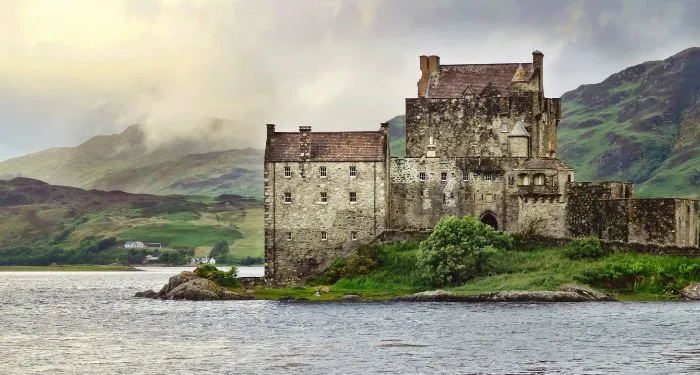On October 21, with two weeks before election day, Donald Trump made a campaign stop near Asheville, North Carolina, where residents were still reeling from the devastation left by Hurricane Helene. He wasn’t there to comfort them but rather to exhort them to make their way through the wreckage to vote. The Federal Emergency Management Administration (FEMA) had no money left to help them, he claimed. “It’s all gone. They’ve spent it on illegal migrants.” If peddling conspiracy theories is the closing argument of his campaign, it’s also a signal of how he intends to govern if returned to office: by lying to undermine public trust in the federal workforce while it tries to respond to the spiraling threats of a fast-warming world. Trump’s war on what he calls the “deep state”—that is, civil servants—and his broader war on the authority of verifiable facts themselves are neatly aligned.
Two weeks after Helene rampaged from the Gulf Coast through the Blue Ridge Mountains, Hurricane Milton slammed into Florida’s west coast. These two catastrophes have thrown the climate implications of the election into relief. Helene deposited at least 40 trillion gallons of water, equivalent to a third of Lake Erie, on the slopes of the southern Appalachians. Hurricane Milton was one of the strongest and fastest-developing storms ever to form in the Atlantic. (Experts say a storm has undergone “rapid intensification” if its maximum wind speeds rise at least thirty-five miles per hour in twenty-four hours; Milton’s winds increased in the same time by ninety-five.) Both storms were fueled by super-heated seas that were “more than 1°C warmer than they would have been in a world without climate change,” according to preliminary analyses.
The storms also laid bare the fragility of our climate safety net: the bevy of emergency response, flood insurance, and infrastructure upgrade programs administered by various agencies. Helene killed more than two hundred people; dozens are still missing. Total economic losses from Helene alone could reach $250 billion. Fewer than one percent of affected homes in the inland counties had flood insurance; uninsured property losses could amount to $30 billion. Here was evidence, as if any further was needed, that the National Oceanic and Atmospheric Administration’s (NOAA) hurricane forecasting and climate research initiatives, FEMA’s capacity for delivering post-disaster aid, and the cash-strapped National Flood Insurance Program all need bolstering. Trump has a different plan for these agencies—he’d like to gut them.
“You’ll be okay,” Trump said at a rally in Michigan on September 27, addressing survivors of Helene even as flood waters were still rising around them. At another rally in Michigan on October 3, he claimed that the Biden administration “stole” federal disaster response funding “so they could give it to their illegal immigrants that they want to have vote for them this season.” These lies fed conspiracy theories on social media, which in turn forced FEMA to divert actual resources to set up a “rumor response” website to knock down misinformation, including, for example, that it was confiscating donated supplies and bulldozing entire towns in order to seize land for lithium mining. NOAA was also forced to create a dedicated website to debunk such claims as “NOAA modifies the weather” and is “steering hurricanes into specific communities.” Republican officials in North Carolina pleaded with people to not spread Trump’s fabrications, because they put emergency workers and local officials at risk. (His accusation that Democratic leaders were deliberately withholding aid from Republican-leaning areas was, as many noted, more like projection: as president he had tried to withhold aid from both Washington and California after catastrophic wildfires in those blue states.)
For Trump, these lies serve a dual purpose. On one level, the FEMA response to Helene—which has been, by all credible accounts, compassionate and competent—gave him a convenient opportunity to weaponize the raw emotions of many survivors in a crucial swing state against his opponent. But they also served his larger project of sowing distrust of the civil service.
While Trump spins his dark fairy tales, the people who will likely staff his administration are preparing to storm the federal bureaucracy. Plans for the Trump 2.0 assault on the administrative state are laid out in intimate detail in Project 2025, the blueprint assembled by the hard-right Heritage Foundation. Two months ago, ProPublica released a leaked Project 2025 video for training potential appointees in a future Trump administration, in which a former Trump official advises that they “will have to eradicate climate change references from absolutely everywhere” across the federal bureaucracy. “Even if you do not work at the Department of Energy—no matter where you work—because of the Biden administration’s executive orders and policy priorities, you will have to look for climate change language and get rid of it.” Some of Project 2025’s other recommendations include dismantling NOAA, slashing FEMA’s budget, sloughing much of that agency’s post-disaster emergency response functions off onto states and local governments, and phasing out the National Flood Insurance Program, which provides the bulk of all flood insurance policies to US homeowners.
The past is prologue here. Trump’s antipathy toward NOAA dates to his first year in office. Across his presidency, his administration made budget proposals that would have slashed the agency’s funding by an average of 17 percent. When NOAA and a dozen other agencies issued a major, congressionally mandated climate report in 2018, Trump couldn’t prevent its release but made a point of disavowing the conclusions: “I don’t believe it.” His administration’s efforts to remove the mention of “climate change” from federal reports and policymaking are well documented, too. (Trump’s transition team skipped scheduled briefings with Obama officials, but they were very proactive in one regard: in December 2016 they made visits to the Departments of Energy and Interior to demand lists of all staffers who worked on climate change.) The Heritage Foundation has reportedly been bombarding federal agencies with Freedom of Information Act requests over the past year, seeking access to communications that mention “climate change.” As president, Trump’s first budget proposed reducing FEMA grants to states and localities for disaster preparedness by half a billion dollars.
Project 2025’s authors want to go further. Their battle plan is both sweeping and detailed. Take, for instance, their proposal to move political appointees into important supervisory roles at the Environmental Protection Agency’s (EPA) air quality planning offices, which develop emissions standards for vehicles and power plants. To make it harder to tighten these and other air quality standards, they would overhaul how the EPA conducts cost-benefit analyses—in particular by minimizing or excluding the health benefits of certain regulations (such as the number of asthma attacks or premature deaths avoided) from its calculations. In Trump’s first term, his EPA appointees attempted to cook the books in this manner by putting vast quantities of data off-limits and enshrining a lie into agency analysis: that pollution levels below air quality thresholds are safe. Yet in recent decades public health research has made it robustly clear that there is no safe level of exposure to fine particulate matter. In December 2020, on their way out the door, Trump’s appointees issued a rule that sought to make thousands of premature deaths from fine particle exposure vanish from cost-benefit analyses, tipping the scale toward the weaker regulations sought by polluting industries. The Biden administration quickly rescinded this new rule; the Project 2025 plan would revive it.
The authors’ crusade against all forms of executive branch climate action would not stop there. They would shutter the Department of Energy’s successful Loan Programs Office, which has invested billions in clean energy startup ventures and major infrastructure projects. They would retool the Office of Fossil Energy and Carbon Management—which works on reducing emissions from oil and gas production and from hard-to-decarbonize industries like cement and steel—by dropping the “carbon management” part and repurposing it for the unrestrained pursuit of fossil fuels. They would even end energy-saving efficiency standards for refrigerators.
Trump has sought to distance himself from Project 2025, even though more than half of its 307 contributors served in some capacity in his administration, campaign, or transition team, as The New York Times recently reported. Whether or not he acts on the most radical recommendations laid out in the document, Trump’s own official campaign platform highlights his pledge to “fire rogue bureaucrats.” For one thing, he will surely reinstate Schedule F, an executive order that he implemented late in 2020 that made it easier to replace career staff—people with technical expertise in atmospheric chemistry, consumer product safety, the health risks of neurotoxins, and the like—with right-wing ideologues whose primary qualification is that they have sworn their fealty to Donald Trump.
*
Many analysts predict that a Trump administration would have the effect of delaying the global transition to clean energy, both by making it easier to produce oil and gas and, more importantly, by dismantling the regulations and incentives that dampen demand for fossil fuels and boost installment of clean energy systems. Trump has made clear that he would like to tear up President Biden’s crowning legislative achievement, the Inflation Reduction Act—a raft of hundreds of billions’ worth of grants, loan programs, and tax credits designed to spur consumers to adopt clean devices like heat pumps and electric vehicles, and to reward companies for building solar farms, battery factories, and other green technologies.
So far, the IRA has worked as intended, triggering a nationwide wave of investment in clean manufacturing. (Trump has called it “the biggest tax hike in history.”) He has vowed to “rescind all unspent funds” the law has earmarked, but to fully repeal the IRA Republicans would need to take control of both the House and the Senate. And even then, a repeal might prove politically unpalatable, since most of the IRA’s subsidies—and the new jobs that come with them—have flowed to projects in red districts. The law also includes billions in incentives for carbon capture and hydrogen projects, which oil and gas companies are keen to preserve. So, like the Affordable Care Act before it, which survived around a hundred GOP attempts to kill it, the IRA is likely to become more popular and durable as time goes on.
Still, Trump could chip away at this historic climate legislation in other ways. He could slow-walk or simply refuse to issue IRA funding or reallocate money to other priorities. While he cannot simply cancel the tax credit provisions, he has more discretion over grant programs and loans, such as those made through the DOE Loans Program Office. And whether the IRA remains intact or is scaled back, he is virtually certain to ax or weaken regulations that limit vehicles and power plants from emitting carbon dioxide, and to withdraw a newly proposed EPA rule that imposes a fee on oil and gas producers for methane leaks. He has pledged to cancel these Biden administration regulations on “day one.”
Indeed, Trump could do most of his damage to climate progress through his executive branch authority, which ideologues in his administration would leverage to undo decades of regulatory protections regarding health, the environment, and consumer safety. Trump also has a baldly transactional relationship with fossil fuel executives; he’s made it clear that he’s happy to grant their wish list of policy changes in return for generous campaign donations. When he was in office, Trump rolled back over a hundred environmental regulations. Trump 2.0 would surely go even further, faster.
As head of a federal workforce numbering over two million employees, Trump would have immense influence over personnel decisions. Rules that don’t get written to rein in industry won’t ever get implemented or enforced. It isn’t just the continuation and enforcement of existing health and environmental protections and climate policies that is at stake, in other words, but also the development of new ones, such as the EPA’s ability to regulate the hundreds of “forever chemicals” that are now present in the drinking water of as many as 95 million Americans.
Meanwhile, the conservative judges and justices that Trump nominated have been kneecapping federal environmental regulators in their own way. In a landmark ruling this past June, the Supreme Court tossed out forty years of precedent (known as “Chevron deference”) that enjoined judges to defer to agency experts on how best to interpret ambiguous language in Congressional laws. The courtroom doors now have been thrown wide open for polluting industries to challenge any regulation they don’t like. This could weaken rules on everything from greenhouse gas emissions to chemical safety—which explains why Mitch McConnell has described killing the Chevron doctrine as the “most consequential” achievement of his tenure as Senate Republican leader.
Finally, a President Trump could take unilateral steps that threaten climate action beyond our borders. For the United States to shirk its carbon-cutting obligations will have a dangerous amplifying effect in the realm of global climate diplomacy. If Trump withdraws from the Paris climate agreement as he has promised, it will send a signal that the world’s largest economy and second-largest carbon emitter is no longer even attempting to pull its weight. Some former Trump aides are floating proposals urging him, if he wins, to withdraw entirely from the UNFCCC, the UN treaty framework for climate talks—which would not only have a chilling effect on global climate finance but also imperil funding that props up the whole system.
*
On top of all these risks, a Trump victory would produce a dangerous kind of epistemic fog. While the specificity of these regulatory battle plans is new, the playbook was written on the second day of his presidency, when he sent out his aides to assert that his inauguration crowds were the biggest in history. That episode occasioned much mockery on late-night shows and opinion pages, but the tactic turned deadly during the pandemic, when he downplayed the threat of Covid-19 and riffed on bleach injections, surely contributing to preventable deaths.
In both instances, Trump’s war on reality was conducted via attacks on executive branch agencies. One of his first acts as president was to call the head of the National Park Service to berate him for tweets of photos comparing inaugural crowd sizes. In his final year as president, he relentlessly lambasted Centers for Disease Control officials in an effort to suppress the truth about the scale and severity of Covid.
The risks of four years of this governing approach applied to the climate crisis are hard to overstate. Trump prizes loyalty above all, though it’s famously unidirectional. Weather and climate researchers have a professional allegiance to data and evidence that precludes massaging the facts—hurricane paths don’t yield to Sharpie corrections of the kind that Trump tried to make for Hurricane Dorian in 2019. So these civil servants are a primary target, and must be brought to heel.
The National Weather Service (NWS) issued forecasts and warnings that prompted many to evacuate in advance of Helene’s and Milton’s devastation. It is operated by NOAA, the same agency that Project 2025’s authors call “one of the main drivers of the climate alarm industry,” which is why they say “it should be broken up and downsized.” They also suggest privatizing the NWS, which would limit public access to weather forecasts and data.
If a climate alarm industry exists, it’s not doing a very good job. Indeed, Helene and Milton are reminders that we desperately need such an industry. Accounts from survivors of Helene, shared in dispatches and videos on social media, mention the phrase “unreal” over and over. A recurring theme in their reports is shock at how quickly modern life can unravel, how fast roads can cave in. “I don’t think anybody, including the government, thought this was what we were gonna get,” said an older resident of Swannanoa, North Carolina, made homeless by Helene.
People keep moving into high-risk zones, buying and building homes in flood- and fire-prone places that will soon be uninsurable. Even though most Americans report being concerned about climate change, it still ranks near the bottom of voters’ priorities in recent surveys—and Kamala Harris hasn’t spoken much about it on the campaign trail. Even under President Biden, who has said he thinks climate change is an existential crisis and who has done more than any president before him to confront it, Americans have been woefully unprepared for the climate upheavals that are coming—and for those that have already arrived.
Many climate scientists seemed stunned by the scale of Helene, which basically created an enormous atmospheric river funneling water inland from the Gulf, and by the speed and ferocity of Milton’s development. One of those scientists was Adam Smith, who analyzes data on billion-dollar-scale disasters for the National Center for Environmental Information, a division of NOAA based in Asheville. Smith had to abandon his desk to search for basement pumps and sandbags ahead of the storm’s arrival; the NCEI itself was knocked offline. Now that it is back up and running, Helene can be added to Smith’s list of billion-dollar disasters. (Of 396 billion-dollar disasters since 1980, only eight have exceeded $50 billion in damages; Helene and Milton are both likely to join them.) “I’m trying to understand the magnitude of what is happening,” Smith told The Washington Post. “I think everyone is still in a bit of a state of shock. It’s almost like a dream. Maybe dream is not the right word. Maybe more like a nightmare.”
It is indeed difficult to grasp the magnitude of what’s happening. Baselines are shifting, extreme events are being normalized, and there is a powerful human urge to simply look away from all the chaos. That will remain true no matter who is in the Oval Office. But it will be immeasurably harder if Donald Trump is given a chance to purge the federal government of people like Smith.




















 English (US) ·
English (US) ·